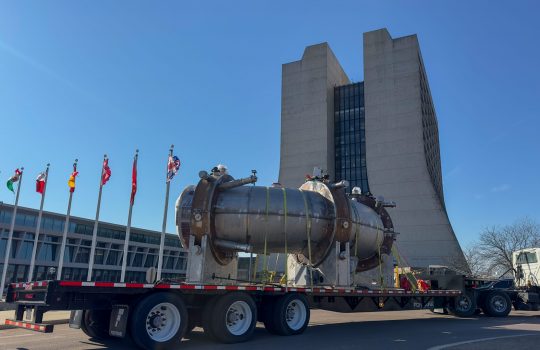Fermilab’s Alex Himmel will spend a large chunk of his career working on the Deep Underground Neutrino Experiment (DUNE), which is expected to be the flagship experiment of the U.S. particle physics community for at least a decade. That’s incentive, he says, to lay the groundwork now to ensure it’s successful.
The Department of Energy has selected Himmel, a Wilson fellow, for a 2017 DOE Early Career Research Award to do just that. He will receive $2.5 million over five years to build a team and optimize software that will help decipher mysterious neutrino oscillations.
The software will measure flashes of ultraviolet light that signal successful neutrino collisions. Neutrinos rarely interact with anything, but in DUNE, researchers will orchestrate collisions by propelling the elusive particles into a massive detector full of liquid argon. Similar experiments have timed the light generated to gauge the location of a collision, but Himmel has proposed using the light in a different way: to confirm the energy of the neutrino by measuring the precise amount of light, too.
DUNE broke ground only this summer at the Sanford Underground Research Facility in South Dakota, but researchers are already speaking up about the long-term, positive impact of Himmel and his research.
“Alex has been a true leader in understanding the physics potential of scintillation light in liquid-argon detectors,” said Ed Blucher, DUNE co-spokesperson and University of Chicago professor of physics. “His plan to develop techniques to make the most effective use of photon detection will help to enable the best and broadest possible physics program for DUNE.”
Himmel has deep ties with Fermilab and neutrinos. His first job was as a summer student at Fermilab when he was 16, and in 2012, he won the Universities Research Association Thesis Award for his research on muon antineutrino oscillations at Fermilab’s MINOS experiment.
Recording light is easy enough, but the challenge in Himmel’s proposal is understanding if the measurement is reliable. Photons released from neutrino collisions will arrive at their detectors deteriorated and distorted from scattering against atoms and reflecting off chamber walls. The light received is not the same as what was given off.
Himmel’s task is to turn back the clock on some of those changes to determine a more precise amount of light generated. Only then can he and other DUNE researchers reliably translate it into the energy of the neutrino.
“What we want to know is, given an amount of energy deposited in the argon, how much light do we see, taking out all the other things we know about how the light moves inside the detector,” he explained.
Having a confirmation of a particle’s energy will be critical to substantiating claims to discovery DUNE researchers may make, since events are likely to be rare and therefore under scrutiny from the scientific community looking for corroborating evidence.
Other DUNE physics goals stand to benefit from this work as well, such as research in proton and neutron decay and supernovae. In these fields, measurements are likewise made of rare, sudden events, marking the importance of making the most of the data. Himmel hopes his findings will also aid science done at other liquid argon experiments now in development.




